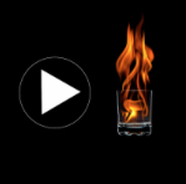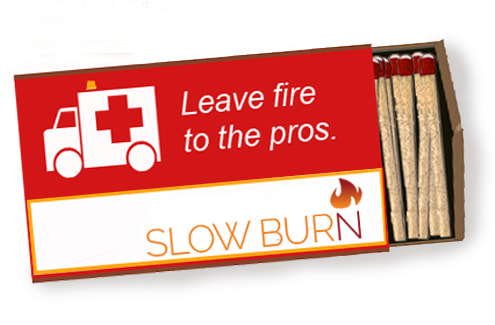 ...or just listen to it here. ...or just listen to it here. Last week, that of June 17, 2017, a portion of the advertising world was focused on the south of France. The Côte d'Azur. Promenade de la Croisette. Le Carlton et Le Majestic. Yes, the Cannes film festival is long over. But we've just seen the passing of this year's festival of creative selling: The Cannes Lions International Festival of Creativity. Why should we care? The Cannes Lions is big. We are people interested in the small. Well, let's remember one of the Slow Burn Marketing mantras: brand your small business like a big business and you can make great things happen. And forgetting a lot of the advertising nonsense that comes out of Cannes (it is a festival of creativity after all, which sometimes becomes creative for its own sake and serves purposes other than ours), Cannes still has a prize category that is near and dear to my heart. MEET THE CANNES GRAND PRIX IN CREATIVE EFFECTIVENESS Yes, even the great global advertising creativity dog pile, or pile de chien, in the south of France has an award for effectiveness. So, are you one of those people? The ones who love to say, "Advertising that wins awards never produces results!" If so, back off, Jacques. There's plenty of award-winning advertising that produces results. And as it happens, I've even created some myself. But I've produced nothing of the magnitude that anyone at Cannes would care about. Nonetheless, the beauty of the effectiveness award is twofold. One, it fires a bazooka right at the guy who loves to say, "Advertising that wins awards never produces results!" AND TWO, IT PRESENTS GREAT IDEAS WORTHY OF STEALING Well, maybe "stealing" is too acute a word. How about, the category presents ideas that can inspire. Because again, this category provides documentable results. It shows the world creative and inventive advertising that made stuff happen. But on a huge budget, right? Nope. Not always. The category's winner this year was a campaign for the Art Institute of Chicago that ran on Airbnb. The campaign was celebrating the first-ever visit to the US of the iconic Van Gogh work, The Bedroom. Or, if you prefer the proper French title, La Chambre à Arles.Or, since Van Gogh was not French but Dutch, Slaapkamer te Arles. I digress. The Bedroom campaign gave people an opportunity to sleep in a life-size recreation of the room in Van Gogh's painting by renting it on Arbnb. THE PERFORMANCE OF THE CAMPAIGN WAS IMPRESSIVE ADWEEK reports that the campaign attracted 133,000 visitors to the Art Institute, and generated $2 million in revenue. And this happened with an investment of just $500,000. I know what you're saying. You can't recreate Van Gogh's bedroom in life size, and half a million bucks is your annual revenue if you're lucky. Plus, didn't I tee this up with a promise of full authenticity and zero media budget? The authenticity here is questionable, and the budget is way above zero. This is not the campaign to which I was referring. But it is fun. THE CAMPAIGN THAT WAS AUTHENTIC AND CHEAP DID NOT WIN It was an also-ran. But it is really cool. You may have heard about it when it was running. It was a social media darling. The campaign is called, The Swedish Number. How's this for affordable: a media budget of zero. No media was purchased for this campaign. None. And it generated $147 million in earned media through international news coverage. SO, WHAT IS THE SWEDISH NUMBER? Sweden is a country with a grand tradition of tourism. Swedes are a gregarious people who love to welcome visitors. They also don't have any standout tourist attractions that make people say, "Hey, let's go see the Swedish fill in the blank!" IKEA? Meatballs? Lutefisk? And Sweden's tourism marketing budget is tiny. They don't have a lot of money to tell you, "We're so much more than IKEA, meatballs and lutefisk." Enter Swedish PR firm INGO. Their solution? Simple: a phone number for Sweden. Anyone in the world could call Sweden on the phone, and a random real live Swede would answer. Yes, I know. This conjurs up images of 12-year-olds dialing Sweden and saying, "Sven, is your refrigerator running?" IT MAY HAVE HAPPENED But far more consistently, random people from around the world called random people in Sweden and had very nice conversations about what it's like to live there. Over 180,000 calls were made to Sweden. They totaled over one year of talk time. 35,000 volunteer Swedish telephone ambassadors fielded calls from 180 countries. The longest call lasted almost five hours. And the media budget was zero. The Swedish Number was promoted with a couple of online videos and some PR, and news outlets worldwide picked up the story and ran with it. Radio and TV programs everywhere picked up the phone and called random Swedes live on air. That included Good Morning America and the largest TV news channel in China. If you search The Swedish Number on YouTube, you can see a Swiss TV host calling Sweden and asking about how all Swedes live in an IKEA and eat free meatballs, and Switzerland and Sweden always get confused for one another. (But only by Americans, apparently.) AND TALK ABOUT AUTHENTIC It doesn't get much more real than talking to a truck driver, a school teacher, a farmer, a pharmacist, a designer... The list goes on. Even the Swedish Prime Minister took a phone call. It was videotaped for YouTube. It's safe to say that more people around the world were suddenly attracted to the idea of visiting Sweden than ever could have been accomplished with an under-budgeted TV campaign. But why? Why did this campaign work? And why did so many people from around the world make so many phone calls to speak with people they didn't know? ONE WORD: CONNECTION Simple, human connection is a powerful thing. The sound of one voice speaking to another. Two people making contact. It's just that simple. And in a world where advertising contrivance runs amok, where everyone clamors to get your attention with offers and absurdities and craziness and scarcity and discounts and yelling-- A simple, human connection cuts through. It shouldn't be that surprising. Some of the most effective advertising campaigns of all time have been based on simple, human connection. At Slow Burn, some of our most powerful advertising campaigns have capitalized on just that. Last week, I was recording Dr. Sam Giveen from New Hampshire for yet another series of radio commercials where he speaks simply and candidly about having a better life with better eye care. Straight talk. Better vision. SIMPLE, PLAIN-SPEAKING, UNGLAMOROUS DR. SAM IS A LOCAL CELEBRITY He has never once made an offer in any of his advertising. He has never pitched product. He has never been a huckster, nor has he hired one. Dr. Sam has always worked for a simple, human connection with his patients. Throughout my career, I've created dozens of campaigns just like that. Recently, in fact, I was asked to record more announcer wraparounds for the legendary Sonny Sardo, an interiors specialist in Southern California. Over a decade ago, I created a campaign that now numbers well over 100 commercials--all of them Sonny talking candidly, telling stories about things like re-upholstery, drapes and custom furniture. He, too, is a local celebrity. He makes bank on making a simple, human connection with the radio listener. BUT THE SWEDISH NUMBER STRIPS THE SIMPLE, HUMAN CONNECTION TO ITS RAW BASICS And with zero media budget, zero actors involved, zero funny copywriting, and zero trendy art direction, a dinky nation of 9 million people got $147 million in free advertising around the world. Pick up the phone. Talk to a Swede. How much simpler could it be? You often don't need huge budgets, fancy production, or The Next Big Idea. Sometimes, all you need to do is be human. Be real. Authenticity. Genuineness. Truth. Beauty. It's all good. And it all works. As always, Blaine Parker Your Lean, Mean Creative Director in Park City
0 Comments
 ...or just listen to it here. ...or just listen to it here. As the faithful fan of the weekly screed knows, we here at the Mountaintop Marketing Fortress are big fans of Jonathan Goldsmith. We've previously discussed the success of The Most Interesting Man In The World. The famous and much-parodied campaign for Dos Equis beer was everything one hopes a good ad campaign will be: entertaining enough to become a meme while producing results enough to make the brand a smash. It's also safe to say the campaign rivals "Got Milk" for the number of stupid parodies being used by other advertisers. Just recently, we heard a local radio station do a lame parody that said, "I don't always listen to radio, but when I do..." BUT HOW SUCCESSFUL WAS GOLDSMITH'S CHARACTER? Yes, the world can be entertained. But are people buying the product? Hard numbers for the success of the Dos Equis campaign are difficult to come by. But by all accounts, it has been a raging success. Various reports peg the results at anywhere from a 22% sales increase in the US (in a time when imported beers sales are slumping), to increasing Dos Equis sales 300% in Canada. So, why did they shoot Goldsmith's The Most Interesting Man In The World into outer space last year? Why did they replace him with giant and less-interesting Augustin Legrand's Most Interesting Man In The World? That, friends, is anyone's guess. SURE, THERE ARE EXPLANATIONS FROM PARENT HEINEKEN An article in Advertising Age from March 2016 quotes the USA's Chief Marketing Officer for the parent company saying, "If you just plug the current campaign in the context of college football, there is something there missing." He said that the then-current version of the campaign is "Looking backwards...You need something a bit more contemporary and something a bit more in today's world." The article then went on to comment how The Most Interesting Man In The World campaign was an odd fit for, say college football. The article concludes with the CMO saying that research had revealed that, "We could go further with the campaign--if we would become more active" and "more present-day." AH, THE POWER OF RESEARCH Research is used to justify all kinds of proactive steps that don't seem to make sense. One of the first and most useful things I ever heard about research came in a marketing meeting from a radio program director. He was talking about doing research to determine the programming direction for the music station in his charge. The first thing he said--or at least, the first thing I remember--is this: Research is never predictive. Yes, in a way, it sounds like he was trying to get off the hook in case his programming decisions failed. But here's the important take away: you truly can never predict how people will behave tomorrow based on what they did or said yesterday. Speaking as a guy who's heard people say, "I'd buy that!", and opened a business selling that, and nobody bought it, I get it. What people will do is never predicated on what they say. AND WHAT WAS THE BEER CMO SAYING? Basically, that their research had predicted the change for Dos Equis was good. Getting rid of Jonathan Goldsmith and replacing him with that French guy and making the stories more contemporary would sell more beer to more people. Go ahead. Ask your friends how they feel. "Nah, he's not as interesting." Cut to the beginning of June this year, and Dos Equis is changing advertising agencies. Usually, that means that the advertising isn't working. But it sounds like the advertising is indeed working--just not as well as they want. Sales are still up for the younger but less-interesting Most Interesting Man In The World. But sales for Corona and Modela Negra are up higher. People are finding their beach and looking for beer brewed with a fighting spirit. SO MORE CHANGE IS GOOD, RIGHT? Who knows. We don't know. We're just disappointed. We miss the wit and personality of the Jonathan Goldsmith edition. And it's one of those classic advertising legends where the guys who created the campaign admit they were clueless. They developed the idea half an hour before the meeting, figuring they'd never sell it. All they were doing was making themselves laugh. BUT WHY ARE WE EVEN TALKING ABOUT THIS? Because, Mr. Goldsmith is back. Not for Dos Equis. And not as The Most Interesting Man In The World. He's back looking a lot like that most interesting guy. A Mexican-tinged guitar is heard playing in the background. He has some gorgeous women sitting with him in a dark room. Liquor is poured into glasses. The glasses clink together. And Señor Goldsmith says, "I told you, I don't always drink beer." He toasts to you through the camera. "Astral. Tequila." A FINE LINE BETWEEN LIQUOR ADVERTISING AND LAWSUITS Astral Tequila has not crossed the line that could get them into trouble, but they are dancing right on it. And while it's nice to see Mr. Goldsmith back in his most interesting chair, it's just a gag. We really can't see it continuing. But as regards flipping the bird to a previous advertiser, it's so much more preferable than the now long-running Sprint campaign featuring Paul Marcarelli, Verizon's former Can You Hear Me Now guy. Yes, we here are in a minority. We find Paul's pitch disingenuous and annoying. Research shows some people agree with us. But it also shows that more people are on board with him. WHATEVER The point is, know your audience and know what they like. Those of us who miss Jonathan Goldsmith's Fernando Lamas character, and who don't appreciate Paul Marcarelli as an unappealing shill, are in a minority. And as a minority of a certain mind, we can be profitable. As a small-business owner, you don't have to worry about the mass market. You have to worry only about the market you serve--which is much smaller than the nation's entire beer-drinking public. For instance, let's say you're a local craft brewer. EACH YEAR, YOU PRODUCE LESS BEER THAN DOS EQUIS SPILLS EACH MONTH It does not behoove you to worry about whether your brand and your marketing play to the nation's college football market. You need to worry about whether your brand and your marketing play to the local specialty market. For example, here in Park City where we live, we are an active-outdoor sports mecca. Skiing, snowboarding, mountain biking, paddling, fly fishing--beer drinkers here get out and do stuff. Constantly. And local Park City Brewery aims right at that market. Their beer, ostensibly, "Pairs well with your next outdoor adventure." The names of their beers evoke the activities pursed by their customer. THEY DON'T GIVE A FLYING CHUPACABRA'S PATOUTIE WHAT DOS EQUIS IS DOING That doesn't mean they should ignore it. It just means they should understand the difference between Dos Equis and themselves, and proceed accordingly. They're never going to be marketing on a mass scale. They're never going to compete with a national brand. They are going to compete with other local brewers like Wasatch and Uinta and Epic. They need to understand how to stand apart and how to be more desirable. Yes, it helps to be piercing and attractive and resonant like Jonathan Goldsmith's character. BUT IT ALSO NEEDS TO BE DONE IN A SCALABLE, RELEVANT WAY It needs to be done in a fashion that resonate locally. And in many regards, their most interesting man should be their own core customer. At Slow Burn, we've always maintained that if you brand your small business like a big business, great things will happen. And we stand by that. We're not dissuading you from doing things correctly. But you also need to understand how to scale it down for your market and your prospect. You can and should look big. But you just need to make sure you keep the reigns on it. Size matters. And so does your approach to maintaining local interest. Can you hear me now? As always, Blaine Parker Your Lean, Mean Creative Director in Park City  ...or just listen to it here. ...or just listen to it here. Recently, I was asked to rewrite an advertisement for a client The client is in a very, very sexy category. Ready? Asphalt. Yay, construction materials! Here's the thing. This stuff doesn't sell itself. Even construction materials require advertising that hits the mark. No, it might not be sexy. But it's an 8-figure business that's selling its product from New England to New Zealand. AND THEIR BRAND IS ROCK SOLID No pun intended. In their category, they have a brand that stands apart, stands out, and stands up to the competition. They're also just fun to work for. The product they sell is a permanent cold asphalt that saves the user around 50% over the cost of traditional asphalt repairs. Traditionally, a road repair is done twice: first with a temporary cold patch, and then later with a permanent hot mix. You've seen the temporary pothole repairs. They're the ones that never last, destroy your suspension, and blow the chrome spinner wheel covers off your Smart Car. This product eliminates the second, hot-mix repair. You just come in, make the repair once, and you're done for good. Guaranteed permanent. They had an ad going out to the trade, and wanted the copy refreshed from a previous version. AND THE HEADLINE WAS NAGGING AT ME The headline, which they were happy to continue using, was "Patch once. Save money." I looked at it. It sat there on the page, mocking me. What is missing, headline? Why are you irritating me? What is it about you that makes you incomplete? I left it. Instead, I went through the body copy and freshened it up. And the answer to the headline dilemma punched through. TWO WORDS That's what it needed. The headline had said, "Patch once. Save money." What it was supposed to say was, "Patch just once. Save big money." All of a sudden, the proposition is more distinctive and acute. You're going to do even less work and save even more money. I sent the headline over to the client. His reply was something like, "Oh. That's better." Apparently, the headline had been nagging at him, as well. And this points to something all too common in writing advertising. THE WRITER QUITS TOO SOON Sometimes it's laziness. Often, it's a time deficit. Sometimes, it's just plain ignorance. Occasionally, it's arrogance. Regardless. Whatever you're creating, whether it's print, digital, broadcast--from a TV commercial to a website to a one-sheet--copywriting is a puzzle to be solved. You can be the writer. You can be the client. You can be a middle man. It doesn't matter who you are. If the words are nagging at you, the copy isn't finished. Of course, this requires that you have the conscience to let those words nag at you. I've known too many ostensible pros whose bar for "Good enough" is way too low. They suffer from an arrogance of ignorance and indifference that shoots everyone in the foot. Those cases aside, there's a simple rule to remember about copy. IF IT'S NOT ON THE PAGE... It's not in your advertisement. Or your website. Or your brochure. Or your commercial. Or whatever else it is you're using to communicate with your customer. And if you care, you will likely get that feeling, the one that says, "This isn't quite right." The "Good enough!" attitude is necessary. There comes a point where you have to stop cutting bait and start fishing. That notwithstanding, one MUST be scrupulous about one's words. METICULOUS ATTENTION TO DETAIL RULES A willingness to parse the copy and figure out what's missing matters. At the very least, it's how a customer is enticed to pay attention. At the very best, it's how you change the world. Somewhere in between those two places is the bank. It's where the advertising generates more response and makes more money. And a good copywriter is going to sweat the details until vowels and consonants are dripping from his pores. Example: last weekend, the Fabulous Honey Parker and I were running in a trail race. (Notice I said, "running," not "competing." Saying that either of us is competitive strains credibility. But we always beat the people who never start.) Someone running ahead of me was wearing a T-shirt from a local university. The message on the back of the shirt, under the university's logo, was this copy: "Envy the past. Fear the future." MY FIRST THOUGHT WAS: "WELL, THAT'S STUPID." A university is about educating and enlightening with the goal of building a better tomorrow. Who would teach anyone to fear the future? Then, I thought, This must be something from the sports department. It's intended to taunt the competition. A cursory Google search reveals that this is a message that has gone onto the T-shirts ever since the university's football team joined the PAC-12. Here's the problem with me running behind a guy wearing a shirt like that. There is entirely too much time to parse the words. I spent several minutes breaking it down and trying to decide whether it made sense. As a message to the competition, which it undoubtedly must be, it's a couple of things. One, it's arrogant, which is dangerous. Those are words that you may find being spoon fed back to you. They will not taste good. Two, it's slightly off target. The words are wrong. As I was running through the dust and rocks, I kept looking at that shirt and rewriting it. I KEPT ASKING MYSELF, "IS 'THE' THE CORRECT WORD?" At the risk of sounding a little too much like an erstwhile U.S. president who, under questioning, said that his answer depended upon what the definition of "is" is, you need to think about these things. Because really, this message is not about a general past or a general future, but about one party's specific past and another party's specific future. A past in which the university's team has reaped the glory of victory. And a future in which the university's team is going to eat the opposing team's lunch. So maybe the message should be, "Envy our past. Fear your future." Because technically, that's really what it's about. It's about you, on the opposing team, looking on our record with envy, and in tomorrow's game, being forced to go headlong and eat dirt. PERSONALLY, I CAN THINK OF A FEW LINES THAT ARE MORE FUN AND LESS RISKY "Fear not. Death will be glorious." "It's a good day to die. Ready?" "What's in your wallet? And do they take it at the ER?" "We'll carry the torch. You enjoy the flames." "Our mascot will look even better from down there." "Come feel the pain." OK. Are they good lines? Mainly, no. But this is the process. I wrote all of that in slightly more time than it took to read it all. Too many people stop writing at the first idea. Sometimes, that idea is brilliant. More often, it's not. OFTEN, THE WAY BRILLIANCE OCCURS, IS BY WRITING TONS AND TONS OF CRAP Writing not nearly enough crap, and thinking only half way, is how too many people approach the problem. Immature copywriters want to be like Zeus, hurling lightning bolts of genius down from Mount Olympus and then prancing off to the next erotic escapade. The experienced copywriter knows: One is not Zeus. One is the erstwhile King of Ephyra, better known as Sisyphus, forced to roll that immense boulder up a hill for eternity. And in case you didn't know, Sisyphus was sentenced to this endless task for... Self-aggrandizing craftiness. How fitting. All of us committed copywriters are doomed to pay the price for our youthful copywriting indiscretions of ego-driven, crafty writing by pushing the copy boulder uphill for eternity. We are doomed to participate in trail races where we run along, analyzing the copy on the back of the shirt of the guy in front of us and rewrite it while trying to not go flailing headlong in the scree and end up with a face full of pebbles. DON'T LET YOUR WRITING GO ONLY HALFWAY Whether you're writing for yourself or for someone else, or someone else is writing for you, the job needs to be complete. It doesn't need to be art. Most of the time, good copy is not artful. But all the time, when it works, good copy is a product of competent, thoughtful craftsmanship. It is not the product of ego-driven cleverness. And it's definitely not the product of lazy thinking. Words matter. And when the right words are on the page, magic happens. Readers care. And they become customers. As always, Blaine Parker Your Lean, Mean Creative Director in Park City  ...or just listen to it here. ...or just listen to it here. Driving along the interstate highway system from dawn to dark can make a brand-thinking ad guy crazy. The Fabulous Honey Parker and I were just taking turns, sitting in that seat, on a long haul from Florida to Utah. As writers in such a situation, we get to write a lot of silly comedy--usually by appropriating other people's unwitting silliness. Example: there's a billboard along the highway somewhere in Missouri. The headline is, "STRIPPERS." The sub-headline is, "Need we say more?" Then, the billboard says about a half dozen more things. THIS IS OUR NEW ALL-PURPOSE TAGLINE It replaces our previous all-time favorite written by a radio account rep in California: "It doesn't smell like urine." Granted, that wasn't written as a tagline, but as a feature about an assisted living facility. But we adopted it as an all-purpose tagline anyway. Think about it. Where doesn't that line work? "Applebee's. It doesn't smell like urine." "The Law Office of John Smith. It doesn't smell like urine." "Slow Burn Marketing. It doesn't smell like urine." Works almost every time. But now? NEED WE SAY MORE? Even if you DO need to say more, and add another half dozen things, "Need we say more" fits all of your all-purpose tagline needs. "Ford Trucks. Need we say more?" "One-Eyed Carl's CrossFit. Need we say more?" "Amazon. Need we say more?" See how easy it is? No thought required at all! "Welcome to Nebraska. Need we say more?" YAY, INTERSTATE HIGHWAY ADVERTISING! But all-purpose taglines aside, one of the other media with which you are routinely confronted on the interstate are long-haul semis. Many trucking lines use their vehicles to deliver messages to the driving public in general, or to truckers in specific. And one of those trucking companies is Kelle's Transport Service. For years, I've seen their trucks on the road here in the west, and I've always wondered: what's the deal with that logo? Seriously. It obviously means something to someone. ALL HAIL THE SKUNK! The 18-wheelers from Kelle's Transport Service have a logo of a grinning skunk in goggles, leaning forward into the breeze, and carrying a flapping Jolly Roger. You know, the skull & crossbones pirate flag. So, a speeding skunk and a pirate flag. Stink up and steal? No idea what it means. But spend enough time on the road staring at those speedy skunks, and eventually the curious among us get driven to Google. Oh, look. Kelle's Transport specializes in refrigerated and frozen food delivery. NOTHING SAYS "GOOD FOOD" LIKE A SKUNK BEARING SKULL AND CROSSBONES, THE INTERNATIONAL SYMBOL FOR POISON Wow. So, what the heck is this really all about? The interwebs knows all! If you dig down deep enough, you find that the Kelle Simon behind Kelle's Transport Service is the son of another trucking entrepreneur. And that man, Dick Simon, used to haul a lot of perfume in his trucks. Those trucks smelled sweet. Thus came the nickname, "Sweet Simon." One day, Sweet Simon turned a truck over to a highly respected detail painter who was so good, he was given carte blanche by truck owners to paint whatever he wanted. SWEET SIMON'S TRUCK CAME BACK WITH A SKUNK Apparently, Mr. Simon was not so sweet on the skunk. But his wife thought it was cute, and he had a load to haul, so the skunk truck hit the road. A logo legacy was born. Nobody seems to know the origin of the pirate flag. Maybe it was just an adolescent goof. But eventually, Mr. Simon's pirate flag was changed to a flag of hearts and flowers--a move that some applauded, and others found just creepy. Either way, that provides some explanation for why the son has a trucking company whose logo is a goggle-wearing skunk speeding along with a pirate flag. It's backstory. It has history. But what does it actually mean? AND IS IT A GOOD IDEA? It doesn't seem to do much beyond be silly. How should the core customer feel about the pirate skunk? Well, if the core customer is someone waiting on a big frozen-food delivery, doesn't the logo convey a feeling of stench and poison? Probably. But is the skunk an effort to speak to that person? Or is the skunk an effort to speak to the prospective employee? If you read trucker lore in online forums, drivers seem to have an affection for the skunk. MAYBE THE SKUNK APPEALS TO THE CAREER DRIVER WHO WANTS MORE Maybe the skunkster promises something better to the right trucker. The messages on Kelle's trucks (and on many others) are telling truckers that they're hiring and they're good to work for. We're not going to examine the veracity of those claims. That's a whole other screed. But maybe the stink-meister and his piracy pennant attract the right driver. Somehow, I doubt it. It just feels too adolescent and without relevance. It's a little like the people who love to go out on their bass boats waving pirate flags. "Ha! Get it?! It's a boat! We're pirates!" Mm-hm. You bet. Good joke. AND THE STENCH-FEST GRAPHICS CERTAINLY DON'T SAY, "MMM-MMM, GOOD FOOD!" More like, "Hey, here's a truckload of flash-frozen botulism!" But here's something I can guarantee: people know the brand. Regardless of what feelings it engenders, the business is identifiable. If a brand is the one way the core customer should feel about the business, this has a couple of things going for it. One, some truckers get a feeling of a legacy employer. Two, trucking customers get a feeling of recognition. It's not deep. It's not even necessarily correct. But in a realm where many brands have nothing, it is at least something. MANY OF THE COMPETITORS HAVE ZERO IDENTITY Many of the competitors are known for...having big white trucks. They're generic. They might be equally reliable. They might be even better--both as frozen-food haulers and as employers. But really, we'll never know. Unless we start to dig and do a lot of research and ask a lot of questions. And who's that proactive? A brand? Yes. A flawed brand? Probably. A good brand? Not really. But it might be better than nothing. Yet, in a perfect world, if it were my business, I'd do everything in my power to appeal to a higher calling and erase all scent of stink and pillage. But that's just me. As always, Blaine Parker Your Lean, Mean Creative Director in Park City |
AuthorBlaine Parker is prone to ranting about any and all things related to brand. In many ways, he is a professional curmudgeon. While there is no known vaccine for this, the condition is also not contagious. Unless you choose it to be so. Archives
February 2022
Categories
All
|
|
© Copyright 2020 Slow Burn Marketing LLC |

 RSS Feed
RSS Feed

